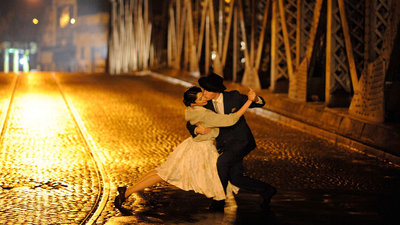
What a strange beast Our Last Tango is. This short documentary (original title Un tango más) has the peculiar distinction of being both inventive and unsatisfying. It’s experimental in ways that work on an emotional level, but as a whole it leaves a viewer wanting much more.
What you may find you want more of is context. Director German Kral’s film tells the story of María Nieves Rego and Juan Carlos Copes, two famous Argentinean tango dancers who were dance partners for decades — and partners in life for much of that time. If you are a dance aficionado, perhaps you know enough about María and Juan to fill in the blanks the movie fails to, but there is little in the film to explain their success.
What is in the film is the tempestuous, emotional side of their story, and this choice — to focus on their relationship — is both admirable and frustrating. For backstory, Kral puts his subjects in settings where they tell their stories to smiling young interviewers. At first, this is a touch confusing: Who are these people and why are they on screen with María and Juan?
It takes a moment to realize: They’re the dancers in the frequent reenactments. They aren’t just playing the younger couple; they’re asking questions about who María and Juan were, how they met, how they danced together. Whether this gives these dancers greater insight into their own performances is hard to say, but it certainly gives that impression. How could you not dance more meaningfully after talking to the person you’re emulating?
There’s a sense of emotional exploration, something being sought and found in the language of dance and yet, tantalizingly, not quite making it to the screen.
While María is vibrant and magnetic, it’s difficult to care much for Juan, who turns out to be an old-fashioned sexist, the kind of man who flat-out objectifies his partner when he refers to her as his Stradivarius. María isn’t a person to him; she’s the tool he used to succeed. He complains, at another point in the film, that María thought he belonged to her, when he believed it was the other way around: She belonged to him, and when he was done with her he set her aside like he would any other tool.
María has a few throwback ideas of her own, but she’s also passionate, curious and somewhat reflective. She’s the one the filmmakers send to visit the locations of old haunts and performance spaces, and you can practically watch memories play across her face as she tells stories of the olden days.
Our Last Tango wants to mine the peculiar relationship between these two — the way their art and their lives diverged, and how they danced on. This works conceptually in the recreations, as their young stand-ins dance lithely through sepia-toned frames, but it all stumbles when the camera turns back to María and Juan themselves. Her story has a triumphant arc, if a mellow one; his seems to taper off, despite all his success.
But if nothing else, both of them demonstrate that being an octogenarian is no excuse for sitting still. If we start now, perhaps we’ll be dancing into our 80s as well. (Bijou Art Cinemas)